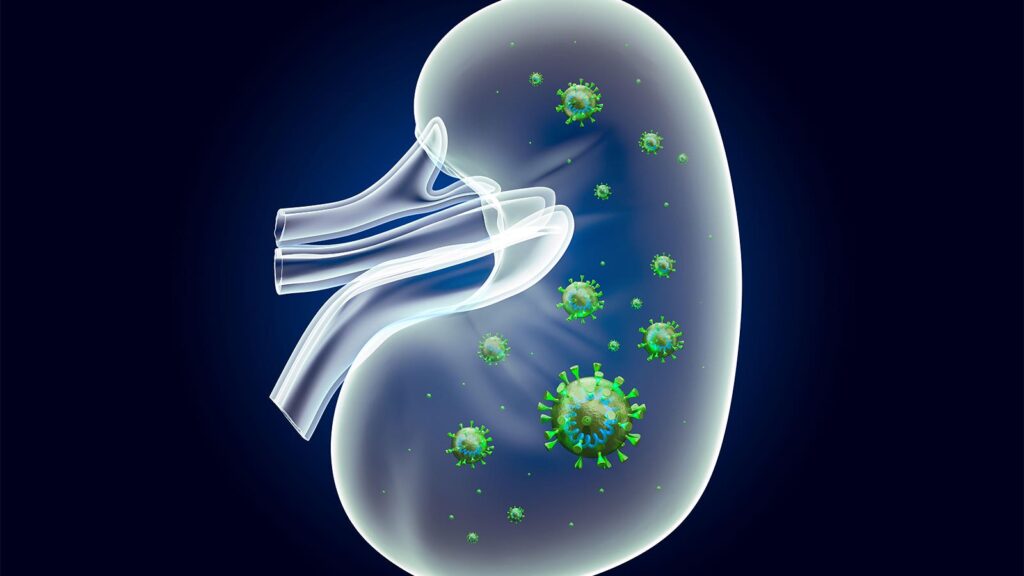Long-term kidney outcomes after acute kidney injury (AKI) weren’t as bad for patients with COVID-related AKI compared with AKI from other illnesses, a retrospective multicenter cohort study suggested.
Among more than 9,500 hospitalized patients with AKI, cases related to COVID-19 were associated with a 33% lower risk for major adverse kidney events (MAKE) compared with AKI from the flu or another illness (adjusted hazard ratio [aHR] 0.67, 95% CI 0.59-0.75), reported F. Perry Wilson, MD, MSCE, of Yale School of Medicine in New Haven, Connecticut, and colleagues.
The lower MAKE risk in the COVID subset was driven by lower all-cause mortality risk (aHR 0.31, 95% CI 0.24-0.39) and lower rates of worsened kidney function (aHR 0.78, 95% CI 0.69-0.88), the researchers detailed in JAMA Internal Medicine.
“Contrary to existing concerns, survivors of COVID-AKI appear to be a resilient population with overall better long-term survival and kidney outcomes compared with AKI associated with influenza or other illnesses,” wrote Wilson and co-authors, calling the findings “reassuring.”
Patients “who survive a COVID-19 infection complicated by AKI may have inherent unmeasured characteristics that are associated with favorable longer-term outcomes,” they noted.
Across the 9,624 hospitalized AKI patients included in the longitudinal analysis, 10.3% of cases were related to COVID-19 and 2.9% were related to influenza, with the rest associated with other illnesses. Compared with the other groups, the COVID patients tended to be younger, have a higher baseline estimated glomerular filtration rate (eGFR) and higher markers of illness severity, and they had worse baseline comorbidity scores and a longer hospital stay.
The COVID-AKI group had the highest prevalence of diabetes (47%), while the flu-AKI group had the highest prevalence of chronic kidney disease (CKD; 31%) and congestive heart failure (CHF; 28%). The other-AKI group had the lowest prevalence of diabetes (32%), hypertension (60%), CKD (16%), CHF (13%), and coronary artery disease (24%).
MAKE — a composite of mortality and worsened kidney function, defined as an eGFR decline by 25% or more from the time of discharge or kidney failure requiring dialysis — was also significantly lower for flu-related-AKI patients when compared with AKI from other illnesses (aHR 0.81, 95% CI 0.68-0.96). However, no significant difference in all-cause mortality was observed for the flu-AKI group compared with the other-AKI group (aHR 0.79, 95% CI 0.59-1.08).
Over 2 years of follow-up, eGFR slopes were steepest for COVID-AKI patients in adjusted models:
- COVID-AKI: -6.79 (95% CI -7.93 to -5.64) mL/min/1.73 m2 per-year
- Flu-AKI: -5.55 (95% CI -7.45 to -3.65) mL/min/1.73 m2 per-year
- Other AKI: -2.60 (95% CI -3.01 to -2.20) mL/ min/1.73 m2 per-year
This “seemingly faster” annual eGFR decline for COVID-AKI patients was “due to an initial rapid eGFR drop post-hospital discharge, similar to that observed during a shorter duration by previous studies,” wrote Wilson and colleagues. They added that this faster decline “may be partly due to this group’s higher eGFR at discharge compared with the other two groups, and partly due to unmeasured confounders contributing to differences in follow-up.”
“Despite higher baseline comorbidities (more than twice the baseline CKD and CHF prevalence of the other-AKI group) and worse measures of illness severity ([modified Sequential Organ Failure Assessments], vasopressor, narcotic, paralytic, and ventilator requirements), the COVID-AKI group had a higher discharge eGFR,” the researchers explained. Around 57% had achieved more than 50% improvement from their eGFR nadir at the time of discharge and 31% had an improvement of 100% or more.
All patients in the study were hospitalized, had AKI, and survived to discharge. Patients were either hospitalized during the pandemic (March 2020 to June 2022) and screened for SARS-CoV-2 or had been hospitalized in the years before the pandemic (October 2016 to January 2020) and had a positive influenza A or B test result. Patients were followed for 2 years after discharge.
Study limitations included residual unmeasured confounders that play a role in longitudinal eGFR trajectory. The study authors said that “replication in broader cohorts as well as assessment of the effects of other kidney dysfunction markers (e.g., proteinuria) and the association of COVID-19-specific therapeutics with kidney function trajectory are worth investigating in future studies.”
Disclosures
The study was supported by the Agency for Healthcare Research and Quality.
Wilson disclosed grants from the National Institute of Diabetes and Digestive and Kidney Diseases, AstraZeneca, Whoop, and Vifor Pharma, as well as fees from Aura Care. Co-authors disclosed relationships with Predict AIN, 3ive Labs, Boehringer Ingelheim, Bristol Myers Squibb, Reprieve, FIRE1, Sanofi, Sequana Medical, Otsuka, Abbott, Merck, Bayer, AstraZeneca, Novartis, Cardionomic, Magenta Medical, WL Gore, Windtree Therapeutics, Lexicon Pharmaceuticals, preCARDIA, Relypsa, Regeneron, Becton Dickinson, Edwards Lifesciences, Cytokinetics, and Lilly; as well as a patent pending related to the diagnosis of acute interstitial nephritis.
Primary Source
JAMA Internal Medicine
Source Reference: Aklilu AM, et al “COVID-19-associated acute kidney injury and longitudinal kidney outcomes” JAMA Intern Med 2024; DOI: 10.1001/jamainternmed.2023.8225.
Please enable JavaScript to view the comments powered by Disqus.
Source link : https://www.medpagetoday.com/nephrology/generalnephrology/108898
Author :
Publish date : 2024-02-26 14:01:07
Copyright for syndicated content belongs to the linked Source.
